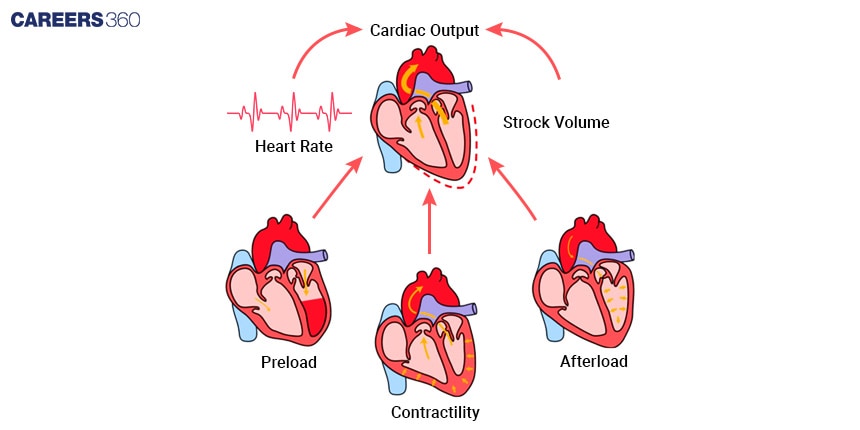Cardiac Output: Definition, Formula, Normal Range And Examples
Cardiac output refers to the amount of blood pumped by the heart per minute, a key indicator of heart efficiency. It is determined by the heart rate and the stroke volume (blood ejected per beat). Cardiac output ensures proper oxygen and nutrient delivery to tissues. In this article, cardiac output definition, factors regulating cardiac output, measurement of cardiac output, cardiac index, regulation of cardiac output, and normal values and variations of cardiac output are discussed. Cardiac Output is a topic of the chapter Body Fluids and Circulation in Biology.
NEET 2025: Mock Test Series | Syllabus | High Scoring Topics | PYQs
NEET Important PYQ's Subject wise: Physics | Chemistry | Biology
New: Meet Careers360 B.Tech/NEET Experts in your City | Book your Seat now
- Cardiac Output Definition
- Factors Regulating Cardiac Output
- Measurement of Cardiac Output
- Cardiac Index
- Regulation of Cardiac Output
- Normal Values and Variations of Cardiac Output

Cardiac Output Definition
Cardiac output can be defined as the amount of blood the heart produces per ventricle every minute. It is, therefore, vital for an individual to know how the heart supplies the body effectively through this form of measurement. Cardiac output is the product of heart rate and stroke volume. Heart rate is defined as the number of beats per minute, and stroke volume is the volume of blood pumped out with each beat from each ventricle. The resting cardiac output in a normal, healthy adult is approximately 5.0 litres per minute. Cardiac output ensures that an acceptable quantity of blood, along with the supply of oxygen and nutrients, reaches the tissues and organs. It also helps to deal with an elimination system within the system of waste products.
Factors Regulating Cardiac Output
Heart Rate: It is the number of times the heart beats in one entire minute and is used as a quantitative measure of cardiac activity. Increased heart rate generally results in improved cardiac output.
Stroke Volume: It is the quantity of blood pumped out at each heart contraction.
Preload: The EDV or volume of blood entering the ventricles.
Afterload: The arterial pressure or the resistance in the arteries which the heart must overcome to eject blood.
Contractility: The forcefulness of each heart contraction.
Venous Return: The volume of blood returning to the heart by the veins.
Physical Exercise: Exercise increases HR and SV leading to raised CO.
Pathological Conditions: Pathologic conditions of the heart, such as heart failure, tachycardia, or hypertension will alter the CO.
Also Read-
Measurement of Cardiac Output
The measurement of cardiac output can be done in several ways:
Direct Methods:
Fick Principle
Thermodilution
Indirect Methods:
Echocardiography
Doppler Ultrasound
Each method bears an advantage and a limitation in terms of accuracy and invasiveness.
Cardiac Output Formula
Cardiac output= Heart Rate(HR) x Stroke Volume(SV)
Cardiac Output Calculation
For example: If the heart rate is 70 bpm and stroke volume is 70 ml.
By the formula: HR X SV
= 70 beats per minute(bpm) X 70 ml
= 4900 ml/min or 4.9 litres per minute.
Cardiac Index
It is a haemodynamic measure that connects the body surface area to the cardiac output of the left ventricle in a minute.
Cardiac Output/Body Surface Area = Cardiac Index
The stroke volume divided by the body surface area is the stroke volume index.
Regulation of Cardiac Output
The cardiac output is regulated through:
Intrinsic Regulation: The Frank-Starling mechanism, where the increased venous return stretches the ventricles, causes stronger contractions to take place.
Extrinsic Regulation: Nervous and hormonal methods of control; for example, the autonomic nervous system and adrenaline.
Normal Values and Variations of Cardiac Output
The general normal range of cardiac output in most adults is about 4-8 litres per minute. Age, sex, and physical condition are other factors that could influence this. Abnormal cardiac output could mean terrible health problems.
Also Read-
| Facts about Blood | Facts about Blood Group |
| Types of Blood Cells | Blood coagulation |
| ABO Blood Group | Circulatory System |
Recommended video on Cardiac Output
Frequently Asked Questions (FAQs)
The normal range is about 4 to 8 litres per minute.
Methods to determine cardiac output include the Fick principle, thermodilution, echocardiography, and Dopplers.
Cardiac output is affected by various factors such as heart rate, stroke volume, autonomic nervous activity, physical activity level, and pathological conditions.
Cardiac output is important in maintaining appropriate blood flow and enough oxygen delivery to the tissues.
Cardiac output would increase with exercise due to an increase in both heart rate and stroke volume.
Also Read
29 Nov'24 01:19 PM
27 Nov'24 07:39 PM
27 Nov'24 07:15 PM
27 Nov'24 05:11 PM
26 Nov'24 08:14 PM
26 Nov'24 06:50 PM
26 Nov'24 05:51 PM
26 Nov'24 04:44 PM
26 Nov'24 03:52 PM
26 Nov'24 02:55 PM


